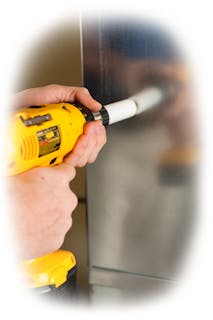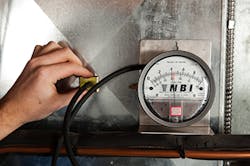Several months ago I wrote a Hotmail article about a new approach to equipment replacement proposals of the future (http://bit.ly/RobF_Future) Let’s take a look at some success stories companies have experienced since they implemented proposals based on a range of field-measured efficiencies of the installed system (50% to 90% efficient) compared to the traditional approach of quoting manufacturer rated equipment efficiency (20 SEER or 95 AFUE).
Two Different Proposals
Traditionally, when HVAC contractors offer a proposal to customers, they feature the brand and model number of the equipment and the manufacturer efficiency rating. Phrases like these are common proposal language:
• Install replacement heating/cooling equipment (Name Your Favorite Brand)
• 60,000 Btu Input furnace, 36,000 Btu cooling equipment
o Option One - 95.0 AFUE Furnace, 20 SEER Cooling $11,800
o Option Two - 90.0 AFUE Furnace, 16 SEER Cooling $9,600
o Option Three - 80.0 AFUE Furnace, 13 SEER Cooling $6,400
Equipment replacement proposals based on the final installed efficiency of the system paint a very different picture for customers to consider:
• Install replacement heating/cooling equipment, properly sized, that meet required efficiency standards, including system renovation upgrades as needed to perform as follows:
o Option One - System to deliver a verified performance of 90% $11,800
o Option Two - System to deliver a verified performance of 75% $ 9,600
o Option Three - System to deliver a verified performance of 60% $ 6,400
However, the typical system often delivers less than 60% of its rated efficiency into the building, making the 95% rated equipment a 57% system, the 90% equipment a 54% system, and the 80% equipment a 48% system. The typical proposal fails to draw attention to this major detail.
The second proposal includes properly-sized equipment properly that meets “required efficiency standards” (probably 82 AFUE and 14 SEER) and is sized to meet the building load based on the delivered Btu of the system.
Actually, in the second proposal, the first equipment option will be smaller than the third option because more heating and cooling Btu will be delivered into the building.
Notice that in both proposals, the three options are priced the same. The first proposal’s cost is mostly in the equipment, the second proposal cost is mostly in the installation.
The difference is the final product, which is actually the real value the customer receives at the completion of every job. The 80% system offered in the second proposal is actually more efficient than the 95% efficiency system in the first proposal.
How This Works in the Field
Mike Greany of AllPro in Southern California has changed the game in his marketplace by offering customers measured and verified levels of installation quality instead of using proposals listing laboratory rated equipment efficiencies.
In our initial phone conversation, Mike changes the discussion from equipment rated efficiency to measured and verified system efficiency. “This discussion raises a question that none of my competition can even discuss. It plants a seed of legitimate doubt that just makes sense to my customers. Do they want to spend their money on rated equipment efficiency or on installed efficiency? It’s an easy decision for them to make.”
Some of Mike’s customers are choosing to keep their existing equipment and spending the money budgeted on improving measured and verified efficiency of their installation. Then they can save up for equipment replacement in the future.
According to Mike, “The old way, customers get new equipment, but are still stuck with the inefficiencies and discomfort they suffered for years. Measured and verified efficiency is why they call us in the first place Competitors lead consumers to believe that equipment rated efficiency is the answer, but it’s not.”
Mike is finding success with this approach in both the residential and commercial marketplace. He uses a gasoline example to teach the principle of system-installed efficiency. “What if you bought $10.00 of gasoline and only $6.00 made it into the tank? That’s what’s happening with your air conditioning and heating system.”
Other Contractor’s Experiences
Other contractors are featuring system efficiency at home shows and leaving the heating and cooling equipment at the shop. “All customers need testing and solutions for defective installations, only a small percent need equipment replacement at any given time” said one East Coast service company.
Generally, most contractors are including a little better than minimum efficiency equipment in their proposals. Many use 14 SEER cooling equipment and 82% AFUE furnaces with variable-speed motors. The job cost stays in the pocket of installers and the company instead of being paid for increased equipment costs. A Texas contractor says “Once customers see the efficiency of the installation is taken care of, then they can more easily justify the cost of much higher efficient equipment.”
Another contractor has increased his service/and sales staff by four this summer to keep up with the demands of measured and verified performance. June numbers just in showed equipment replacement and renovation sales tripled over the previous month. The company can’t keep up with over 500 new leads in the last 30 days.
One husband and wife sales team in the Midwest has developed a rock-solid approach using measured and verified installations. He goes to work testing the system and she educates the customer about the solutions system renovation brings to comfort and efficiency problems. “The score of the installation efficiency always backs up the specific benefits the customers are looking for. The score represents benefits and shows our customers that we delivered what we promised in the proposal.”
One contractor reports the value of the system upgrades required to deliver promised comfort and performance are often worth nearly as much as the equipment replacement costs. “My margins are much higher on system renovation work than equipment replacement. Equipment replacement is a commodity; system renovation and performance are custom work.”
Testing Required The testing and calculations required to measure and verify system performance are found in the principles of airTo score system performance, a variety of time-tested measurements and calculations are used. Airflow and pressure measurements need to be taken at the equipment and at the registers and grilles. These measurements must follow specific protocols found in ASHRAE Standard 111. Temperature measurements (included in ASHRAE Standard 41.1) and calculations (found in ASHRAE Standard 152) must also be applied.
Systems are scored based on the measured Btu delivered by the system into the building envelope. Equipment measurements alone won’t identify installed performance due to losses that occur in every system.
This test method represents a new frontier in customer service and energy efficiency.
Customers are beginning to understand how performance-based contractors are redefining efficiency. Customer’s decisions were once made based on an idealistic number assigned to a box -- now they can have a real measured and verified number depicting the level of installation they actually receive at the end of the job.
Rob “Doc” Falke serves the industry as president of National Comfort Institute -- an HVAC-based training company and membership organization. If you're an HVAC contractor or technician interested in a free test procedure to score the performance of your installations, contact Doc at [email protected] or call him at 800-633-7058. Go to NCI’s website at nationalcomfortinstitute.com for free information, articles, and downloads.











